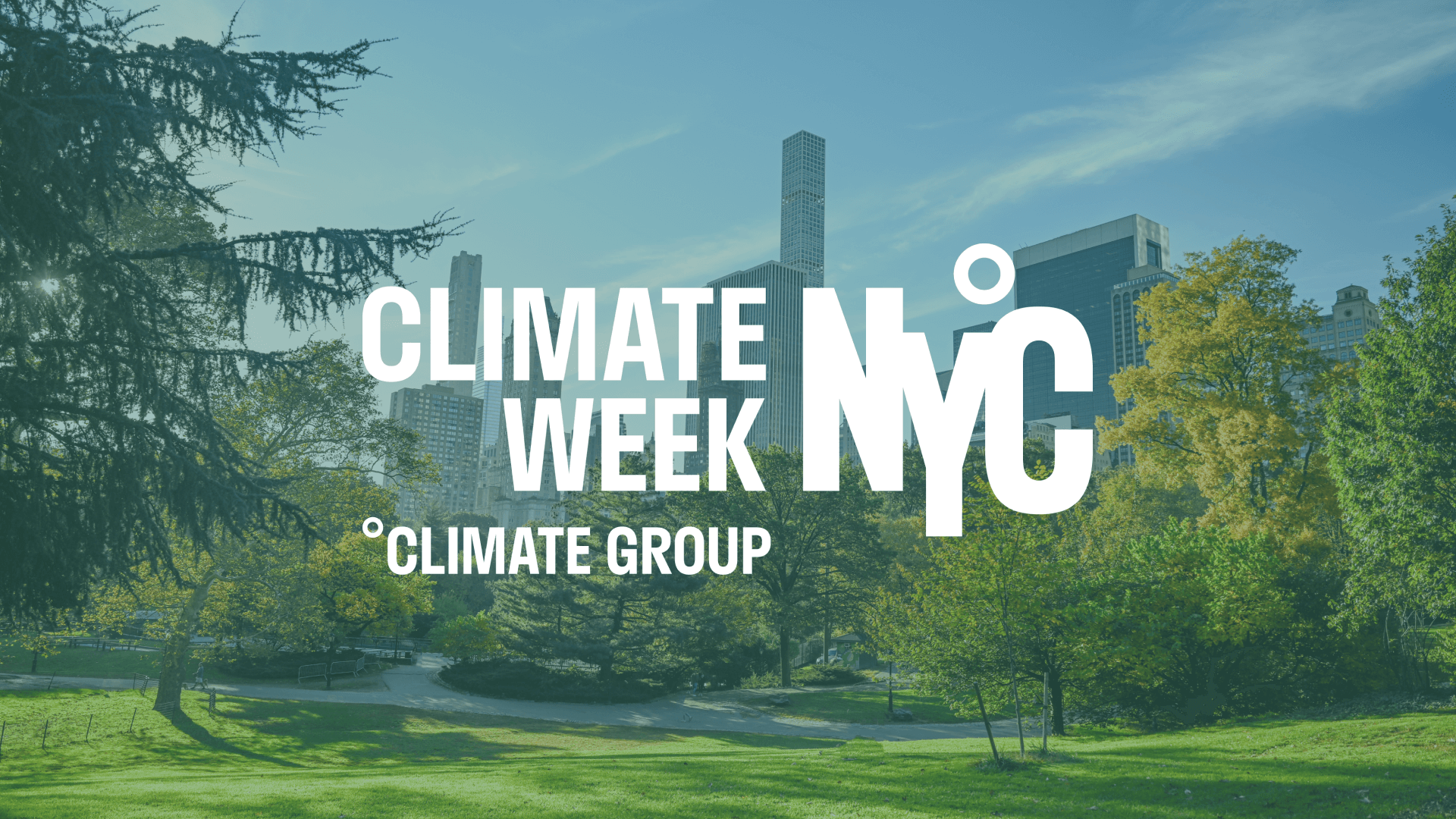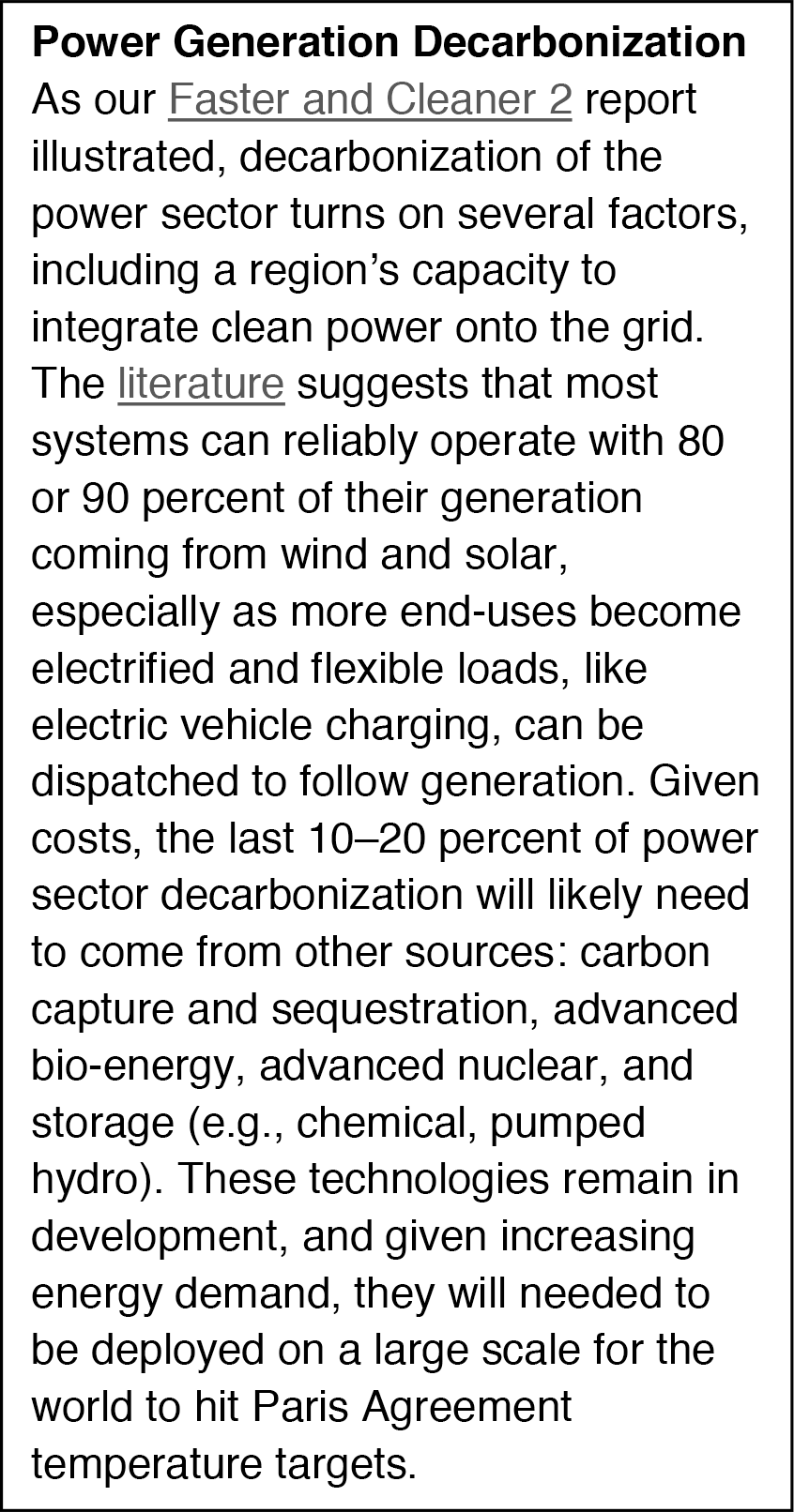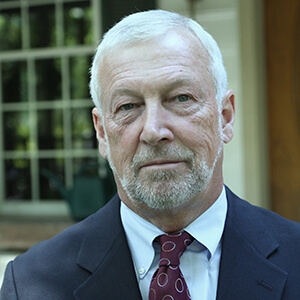
If the term "stocktake" conjures up images of store clerks with clipboards perusing backroom shelves, then you may not have read Article 14 of the Paris Agreement lately. It outlines an obligation, known as the Global Stocktake, for countries to assess progress toward the purpose and goals of the agreement every five years, with the first report due in 2023. In addition to assessing progress, the Global Stocktake will shape the next round of nationally determined contributions (NDCs) that are due by 2025.
We already know that the gap between what countries have promised and the action that needs to be taken to limit dangerous climate change is large, so it seems logical to assume that between now and 2023 countries will be doing the equivalent of a long hard look in the mirror after a late night out. If improvements to the NDCs due by 2025 are to be informed by this assessment, then we would expect the rapid and forceful application of soap and hair gel.
While its 2023 deadline may seem far off, Global Stocktake planning is already underway, and it is far from simple. What is to be included is subject to negotiations that should be finalized at COP24. By the nature of the mandate and process, some aspects may fall outside the scope of the effort. In other cases, there is a lack of available data and analysis. For example, commitments are made nationally, but the Global Stocktake is a collective exercise. With 195 countries signed on to the Paris Agreement, the Stocktake might only paint a broad-brush image of what is happening to curb climate change, reducing its usefulness to countries hoping to take action based on its results.
For the Paris Agreement to succeed, the Global Stocktake has to succeed as well.
Further, assessments of adaptation, financial flows, loss and damage, and equity do not have as well-established methodologies as those related directly to mitigation, and this is a potential blind spot for the Global Stocktake.
Despite these issues, one thing is certain: For the Paris Agreement to succeed, the Global Stocktake has to succeed as well. These high stakes and the inherent complexities of international climate policy demand transparency, and engagement from civil society.
Accuracy, transparency, and inclusiveness are essential
This is where the Independent Global Stocktake (iGST) comes in. A growing collaboration between the ClimateWorks Foundation, the World Resources Institute, the University of Maryland, IDDRI, Climate Action Network, Wuppertal Institute, and a host of other analysts and advocates, iGST is a new platform that will organize and amplify inputs to the Global Stocktake process, helping Parties make the most of the opportunity.
The goals of the iGST are first to ensure that the Global Stocktake is usable by individual countries as an input to their decision-making on NDC improvements, and second, to bolster those areas that are difficult to assess and will need additional inputs to capture. In the first instance, the iGST will provide information that helps break down the implications of a global assessment for particular countries and regions, and will work with interested Parties to uncover how lessons learned can be acted upon. In the second, the iGST will tackle issues like enhancing the methodology behind assessing progress on adaptation; aggregating and characterizing shifts in financial flows; and understanding how to include equity in a system built on bottom-up commitments that need to reach ambitious collective goals.
ClimateWorks is launching the iGST at a joint side event with Wuppertal Institute at COP24 in Katowice on December 11. Over the coming few months we will support finalization of the Global Stocktake’s modalities, while looking to the UN Secretary General’s climate summit in September 2019 as a first opportunity to have Parties show their hands. At that point, we should have a strong sense of what kind of ambition Parties have for the Global Stocktake and its influence on future NDCs, and how they intend to incorporate the full set of goals of the Paris agreement. Drop us a line if you want to follow along. We’ll provide the clipboard.

When people outside the UK think of London, my home city, they imagine grey skies, drizzling rain and a bustling economy. It is often like this, but each year for a few glorious weeks (not always consecutive to one another) the city experiences a proper summer.
I have always been of the opinion that London in the sunshine is one of the most pleasant places to be in the world. But the recent heatwave has put this opinion to the test.
London is not a city built for extreme heat. Very few homes are air-conditioned. Nor are most of the rail lines that keep the city moving. This has resulted in tired, sweaty commuters being forced to cram themselves into train carriages at temperatures that are far beyond the legal limits allowed for transporting cattle. This experience is not unique to London, but common around the world.
While it has undoubtedly been a good time for selling ice cream and fans (by the way, the cooling technology economy is estimated at $140bn a year and growing), the overall impact of higher temperatures on worker productivity is negative. Research suggest that labor supply and labor productivity decline sharply when temperatures rise above threshold values between 20° C and 30° C.
The simple fact is that society does not function in the way that we would like when people are too hot. When people are hot they think more slowly. They move more slowly. They sleep less well. And they can even become more aggressive.
Heat can cause and exacerbate a range of health conditions, from heat exhaustion and heat stroke, to heart and lung conditions, and psychiatric illness. In the most severe cases heat can even lead to death, especially for children and the elderly, as we have seen with the spate of heat-related deaths so far this year – Japan, Karachi, Quebec, and South Korea. In Japan around 23,000 people were admitted to hospital with heat stress.
The most obvious way to deal with heat is with cooling. When people are thermally comfortable they are better equipped to lead healthy, prosperous lives. However cooling down is not easy for everyone.
A recent report from Sustainable Energy for All, a global non-profit group, estimates that today there are 1.1 billion people worldwide – most of whom are living in the regions that are most vulnerable to rising temperatures – that do not have access to any modern form of cooling.
By 2050 the work capacity losses in South East Asia’s construction sector during periods of hot weather are expected to be as high as 50% just for moderate work in the shade. For those working in direct sunlight this rises to as much as 70%. In fact, overall by 2050, work-hour losses by country are expected to be at least 2% and as high as 12% for in the worst effected regions for world including West Africa and South Asia. This loss in productivity will equate to billions of dollars of economic value wiped out, which for many of these countries is a significant financial blow.
Keeping people cool is an urgent task. The dilemma we face is that as economies grow, demand for cooling skyrockets. And because markets are dominated by polluting chemical using, energy sapping air-conditioners which could account for up to a degree Celsius of warming (ie the rest of the global carbon budget), this growth is a chilling prospect.
In fact, a particular class of refrigerant gases known as HFCs are some of the most potent greenhouse gases in the atmosphere, with impacts thousands of times greater than a similar amount of carbon dioxide. This is why 197 countries have now signed up to the Kigali Amendment of the Montreal Protocol, aiming to phase down their production and consumption by over 80% across the next 30 years. Countries must stick to this deal.
This, however, is only one side of the coin. According to the International Energy Agency, by 2050, the total electricity demand for cooling globally is expected to equal the total electricity demand for EVERYTHING in the US, Japan and the EU combined.
This is why at the work we are doing through the Kigali Cooling Efficiency Program is so important. By focusing on the energy efficiency of cooling we aim to increase and accelerate the climate and development benefits of the Kigali Amendment to phase down HFCs. With energy efficient, clean cooling we can help to unlock a sustainable and prosperous future for all.
The world needs higher energy performance standards for air-conditioners. In particular, China, which produces about 70% of all air-conditioners globally, needs to step up, including stopping the export of low efficiency (junk) air-conditioners that it does not deem worthy of selling at home.
But we also need solutions for people for whom an air-conditioner is out of reach and who live in buildings with poor insulation. They need affordable and reliable cooling technology that delivers cooling for them at work, rest and play – mobile fans, gel pads, wearables and portable coolers, are among the range of possible solutions. Green public spaces and shading are also critical for those most vulnerable, especially in cities.
If we succeed in taking efficient, clean, cooling solutions to every corner of the world we will address some of the biggest issues faced this century – health, productivity, and climate change. If we don’t succeed we face a future with increased mortality rates due to heatwaves and a human development crisis. The Government of Japan declared its recent heatwave a ‘natural disaster’. A disaster it was, but it was not wholly natural. Scientists estimate that heat waves we are witnessing searing in Europe in 2018 are twice as likely to be happening due to human made climate change. We need to find ways to simultaneously keep people and the planet cool. If we fail on the latter, we will fail on both fronts.

The world of energy is changing rapidly and the World Bank can accelerate this positive change.
Last year at the One Planet Summit in Paris, the World Bank boldly committed to end upstream oil and gas financing after 2019, to allocate 28% of its portfolio to climate action by 2020, and to increase the transparency of climate impacts from its investments. All of which follows its precedent setting commitment in 2013 to restrict investment in new coal plants. As a result, the World Bank is viewed by many, including climate philanthropist, as both a leader and partner in mitigating climate change and fueling the clean energy transition needed by its client countries.
We welcome – and support – the Bank’s continued climate leadership. We have increasingly partnered with leading climate friendly bilateral and multilateral development agencies to spur clean energy investment around the world. We were instrumental in organizing and capitalizing the successful US-ICEF program, in partnership with the U.S. Overseas Private Investment Corporation, focused on early-stage project development for clean energy projects in India. There are now active conversations in our community about similar facilities that would help drive a pipeline of clean energy projects in other regions where clean energy finance faces many challenges. We need and want to work globally with more leaders such as the World Bank.
The exception to the World Bank’s otherwise progressive clean energy portfolio, is its engagement in Kosovo. While the Bank has been helping Kosovo address its energy challenges through energy efficiency improvements, renewable energy development, and regional power market integration, it still has not moved beyond its support for the last remaining coal project in its pipeline, a legacy coal plant.
Such a plant may have made sense a decade ago when it was first proposed: the levelized cost of energy (LCOE) from conventional coal stood at about $60/MWh, while solar then cost around $400/MWh, and wind around $70/MWh. But a lot has changed since then.
According to recent analyses, the benchmark global LCOE for solar is $70/MWh and wind is $55/MWh and in many geographies, both are cheaper still. Consider that France just tendered 500 MW of solar power for $60/MWh. That matters because Kosovo has similar solar potential to the sunniest parts of France, which means it could also greatly benefit from these ever-decreasing prices. Meanwhile, an external expert panel to the World Bank priced a new coal plant in Kosovo at nearly 50% more (about $94/MWh) than a decade ago. Suffice to say, clean energy is now dirt cheap.
This declining solar price provides Kosovo with a great option to embrace cheap clean energy – enabling it to step into an energy economy more suited to the times and to future EU climate accession. Equally important is the number and quality of jobs created by the renewable energy and energy efficiency sectors, which was a main impetus behind the Bank’s multimillion dollar Kosovo energy efficiency and renewable energy project.
It appears the bank has been paying close attention to these trends and is now actively reconsidering its support for this legacy coal plant. We welcome this move and urge the bank to take a clear comprehensive view of the energy transition facing Kosovo as well as the rest of Europe — air pollution from coal is not contained by borders.
The good news is that Kosovars and their elected officials support a clean energy future. The coal plant was never in the country’s best interest, and the people of Kosovo are demonstrating their desire for clean, affordable energy and 21st century jobs, as opposed to returning to the pollution-choked skies of their past. Now is the time for the bank to cement its leadership, once again, to advance a clean energy economy by cancelling its investment in the Kosovo coal plant and ushering in a new era of cheap, clean energy in the Balkans. An act that will be deeply welcomed by Kosovars and greatly appreciated by all of us in the climate philanthropy community.

Identifying the source and scale of non-CO2 climate pollution has been difficult and contentious, proving that when it comes to fighting climate change, the old carpenter’s adage ‘measures twice, cut once’ is more than apropos.
Two recent New York Times articles address the importance of curbing non-CO2 greenhouse gases, and highlight organizations that, with support from ClimateWorks Foundation, are working around the world to drive down emissions.
Last Thursday, the Times wrote up the result of a massive study by the Environmental Defense Fund (EDF) and its partners which showed that methane emissions from US oil and gas infrastructure is 60 percent higher than the US Environmental Protection Agency (EPA) estimates. This is the latest, and best researched, salvo in a years-long battle to ensure that the US switch from coal to gas isn’t inadvertently increasing climate pollution because of methane leakage.
The global warming impact of methane is up to 80 times that of CO2 over a 20-year time span, so even small amounts of leakage are significant, and costly. EDF found that $2 billion worth of gas is being wasted every year. Once identified, leaks are relatively easy and cost-effective to repair. As a result, there should in theory be incentive for the industry to clean up its act, but, the industry is dragging its feet on voluntary initiatives and resisting the best data. This new study should put the ball back in the court of polluters to clean up their act.
$2 billion worth of gas is being wasted every year.
Yesterday, the Times followed up a recent Nature article which showed that atmospheric measurements of chlorofluorocarbon-11 (CFC-11), a chemical banned under the Montreal Protocol, had stopped falling steadily since 2013, indicating new sources of emissions. As an ozone-depleting super-greenhouse gas, it represents a double whammy for the environment. Researchers now suspect that CFC-11 is being manufactured and used in China, contrary to Chinese law, but where enforcement of central government edicts can be challenging and complex with myriad small-scale producers.
Thanks again to sharp-eyed scientists, shutting down these sources of CFC-11 could prevent 1.8 billion tons of CO2 emissions through 2030. The Chinese government has welcomed analysis and technical support aimed at helping it enforce its policies in the past, and we hope they will respond in the same manner in this instance.
Because super pollutants like methane and fluorocarbons are so potent in such small quantities, knowing what’s being emitted where is of paramount importance. As we have been since 2009, ClimateWorks will continue to support research and advocacy focused on the importance of monitoring non-CO2 greenhouse gases as the basis of a strategy to cut their emissions in line with the goal to prevent dangerous climate change.

Large-scale electrification of three sectors—transport, buildings, and industry—is an essential component of moving the world onto a low-carbon pathway and achieving net-zero emissions by mid-century. Further, done right, end-use electrification can be a boon to increased integration of clean renewable power, especially for those applications that have flexibility when they consume power. Beneficial electrification that maximizes climate benefits requires a strategic framework including which end-use activities should be targeted for wide-scale electrification now or later (or never) and which types of policies and interventions provide the greatest potential for scaling on a timeframe consistent with climate goals.
Note: We appreciate the feedback we received from our partners on the original end-use electrification blog. We’re listening. In light of that feedback, we’ve updated and expanded it to reflect the timing of certain end-use opportunities, the efforts required on the path to scale, and the need to reassess as technology progresses. We will continue to watch this evolving space and look forward to more conversations on this important topic.
Last year the ClimateWorks Foundation initiated a project to explore priorities for climate action and philanthropy in light of the need to achieve net-zero emissions by mid-century. Among the five priorities identified was pursuit of simultaneous power generation decarbonization and wide-scale end-use electrification. While the former accelerates, attention is turning to the latter, which requires a nuanced approach, one that recognizes that some sectors are ready for scaling today, while others need further development and some will remain hard or even impossible to electrify and thus will need other low-carbon alternatives.
Electrification Scale-up Timing
Switching from direct fossil-fuel use in end-use sectors (buildings, industry, and transport) to electricity allows those end-use sectors to benefit from a decarbonizing power sector and the power sector to benefit from the flexible load that end-use electrification can provide. Two dimensions are important to consider when determining when this switching is advantageous for a particular activity including emissions intensity of the grid (Figure 1) and technological readiness.

Because the emissions intensity crossover point and technological readiness vary across end-use applications, it makes sense to group activities according to their current amenability to scale electrification.
- Scale now those activities that can quickly and cost-effectively benefit from electrification with available technologies at current or expected levels of emissions intensity.
- Scale later those activities that (1) will benefit from electrification at future expected emissions intensity levels and/or (2) rely on technologies still under development.
- Hard to electrify activities require alternative approaches because at present they face very high barriers to electrification and those that (1) might never benefit from electrification in terms of emissions reductions or (2) lack a counterpart technology or application that is readily electrified.
According to this framework, certain end uses would be prioritized for scaling electrification now, other end uses would be pursued/scaled as technological readiness and cost-effectiveness warrant, and yet other end uses would require alternative development of non-electric low-carbon strategies (Figure 2).
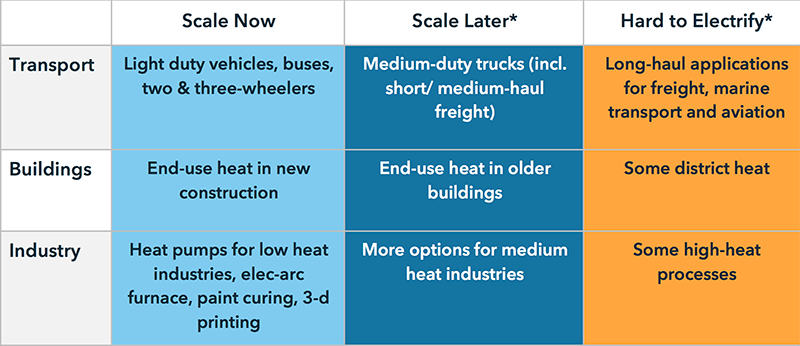
Scale Now
Climate philanthropy has multiple near-term strategies to promote electrification, most notably in the transport sector, where progress is already taking advantage of decreasing emissions intensities in the power sector and smart charging provides the opportunity to increase the value of fixed grid assets and facilitate additional renewable integration. The relatively high vehicle efficiency of electric vehicles (3X more efficient than combustion) will only improve the GHG benefits as grid decarbonization continues.
End uses in the buildings and industry sectors are important to get started but more complicated. In the buildings sector, emphasis has been on new construction, where cost-effective technologies exist to leapfrog to electrified devices while avoiding the buildout of additional natural gas infrastructure.
In the industry sector, the bulk of fossil-fuel use is for process heat, and electrified counterparts come with technological and cost barriers. However, low-heat (<100⁰C) processes used in production of food and beverages, textiles, and some pharmaceuticals and some medium/high-heat (<400⁰C) processes are already being electrified with efficient heat pumps and resistance heating (e.g. drying, paint curing, carbonizing carbon fiber).
Scale Later* (but act now)
Some end uses have path dependencies that can be addressed by waiting until emissions intensities of generation reach the crossover point OR by working today to overcome geographic, structural, cultural, financial, and technological barriers in anticipation of future scaling. Especially where technological readiness is a barrier, interventions such as RD&D, pilot or demonstration projects, and the creation of early niche markets can be effective ways to build confidence in the solutions.
Take, for example, space heating in existing buildings. A switch from natural gas to electricity for heating might already make sense in terms of emissions reductions but because of high-cost or lack of a competitive retrofit industry, it may require an extended period of pilot retrofit programs to build confidence in larger-scale interventions.
The transport sector offers clearer scale-later cases. In the freight subsectors, the challenge is lack of commercially available and rapidly deployable technology. Electrified freight is in the pilot testing and early commercial stage, and already we are seeing factors that might make a straightforward scale-later (or even scale now) case for some kinds of freight – for example, short -haul delivery and drayage trucks.
The time it takes for stock turnover and market development plays a large role in all end-use sectors. Even for scale-later opportunities, it will be important to get started now developing the technologies, addressing market barriers, and building confidence in the solutions in preparation for scale adoption.
Hard to Electrify* (but watch closely)
Finally, some end-use technologies—from an emissions, technological, or cost standpoint—will likely continue to be difficult to electrify well into the future; either the barriers are too great to overcome or these end uses might be better addressed through other means.
In the transport sector, long-haul commercial shipping and aviation will be very difficult to electrify as will some forms of industrial high-heat. These modes may be better suited to energy carriers such as advanced low-carbon biofuels, hydrogen, and/or fossil-energy with carbon-capture and sequestration (CCS). In addition to low-carbon fuels, these hard-to-electrify sectors can benefit from other mitigation opportunities like additive manufacturing and greater materials efficiency.
It’s important to note that we should reassess these categories and what is included in them on a regular basis, especially as technologies continue to improve. Things that were once thought difficult to electrify (e.g. buses) are now here and ready to scale today.
Key Philanthropic Opportunities
Climate philanthropy has many opportunities to support wide-scale decarbonization and electrification. To take advantage of them, the following actions are recommended priorities:
- Shift emphasis from renewables deployment to grid integration. The rapid pace of renewables deployment in the power sector in many geographies suggests that philanthropic resources could be redirected to scaling up beneficial electrification and integrating clean electrons onto the grid, especially in China, India, the EU, and the United States.
- Continue building philanthropic support for transportation electrification. Dramatically moving the transport sector onto a climate-safe path is within reach. Support should go to expanding regional policies and programs where government ambition outpaces local capacity and to building politically powerful local and global coalitions among governments, labor, consumers, corporations, utility companies, and groups working on equity and social justice.
- Advocate for innovation. Electrification of end uses depends in large part on continued technological innovation, yet public (and philanthropic) funding for innovation activities is relatively low. Promotion of increased innovation spending and policies that encourage private sector innovation is critical to move technologies from the lab to commercial scale.
- Support carbon removal strategies. To meet 2050 emissions mitigation targets, carbon removal must accompany other mitigation strategies. Resources are needed to study the tradeoffs associated with removal approaches and to advocate for market developments and finance. Better understanding tradeoffs will show when pursuit of CCS is advantageous, especially in hard to electrify, high-heat sectors.
- Avoid natural gas lock-in. Cheap natural gas threatens to displace zero-carbon power generation, requiring examination of the role of accelerated depreciation of old natural gas units. Beyond the power sector, natural gas is a feedstock to the chemicals industry and a source of energy in the buildings and industry sectors, creating cost barriers for a transition to electrified technologies or use of advanced low-carbon biofuels or hydrogen.
- Support carbon pricing. Carbon pricing, either in the form of carbon taxes or cap-and-trade, can be a powerful policy to drive decarbonization and beneficial end-use electrification. This is especially true where the challenges and solutions are highly heterogeneous such as industrial processes. By including a meaningful carbon-price in decision-making, private-sector players can make intelligent market-based decisions about when it makes sense to electrify or take other actions to reduce emissions.
- Don’t forget to address the difficult to electrify sectors. Many large, energy-intensive, high-heat industries require support for low-carbon alternatives. In the context of aviation and other hard to decarbonize industrial applications, support is needed for low-carbon liquid fuels, hydrogen, and continued efficiency improvements.

As recently as late 2017, there was reason to be concerned that Southeast Asia was a frontier for coal plant expansion. This was driven, in large part, by Indonesia’s plans to add over 35 gigawatts (GW) of new coal capacity, more than 2.5 times the amount currently needed. Those plans may have since stalled, with the Energy and Mineral Resources Minister’s freeze on new Power Purchase Agreements in Indonesia’s largest consumption area, the Java/Bali electricity grid, which serves 100 million people, two-thirds of the country’s population.
This respite is critical to the health of those living in Jakarta, the nation’s capital, and in surrounding areas. The plans to build four new coal plants around Jakarta would have added to the eight plants already encircling the city.
Indonesians are alarmed about air pollution and the ensuing health impacts. Greenpeace Indonesia projects that the proposed coal plants in Jakarta would cause over 10,000 premature deaths. With elections in early 2019, air pollution looms as a critical political issue.
Public concern is one of the reasons why Indonesia’s Ministry of Environment (MOE) announced late last year that it would revise ambient air quality standards and enact new standards for coal-fired power plants. However, pushback from utilities and the coal industry has been swift, with familiar claims of high pollution abatement costs that have stalled policy progress on clean air and energy.
The emissions abatement measures outlined in government drafts set limits far above the 250 mg/m3 standards required to ensure effective controls for both sulfur dioxide (SO2) and nitrogen oxide (NOx), and far above the levels that modern pollution controls can achieve. The proposed emission levels of 30-50 mg/m3 for particulate matter are also higher than the concentrations that new and existing units typically achieve.
Indonesia’s Proposed Emission Standards by Age of Plant

Industry claims that standards to protect public health are prohibitively expensive have been debunked by Indonesian NGOs and former US EPA air quality experts, who estimated that for approximately $2.70 per year per citizen, all of the existing coal-fired plants serving the Java/Bali grid, and its 100 million residents, could be equipped with modern air pollution controls.[footnote tooltip=”Averaged over the financing period for these controls and assuming that the cost of these improvements is shared proportionally between residential, commercial and industrial users.”][/footnote] That translates to about a penny a day per resident to slash over 90 percent of the emissions from existing plants.
That translates to about a penny a day per resident to slash over 90 percent of the emissions from existing plants.
For Java, which has approximately 21,000 megawatts (MW) of existing coal-fired generation, 6,500 MW under construction, and 5,000 MW under procurement, efforts to develop stricter standards are critical to public health. Currently, less than 25 percent of this fleet is equipped with the highest quality pollution control equipment for SO2, and there are no known plants with the best pollution controls for NOx. This condition is intensified because the coal-fired fleet is quite new and unlikely to retire anytime soon.
Capacity (MW) vs. Commercial Operation Date of Java/Bali Grid

According to MOE, the proposed standards would affect a minimal reduction for only 25 percent of the fleet. Indeed, the proposed standards are set at levels below the average performance of the existing fleet.
Proposed Emissions Standards

For several categories of plants, the worst performers meet the proposed standard for SO2, without any new controls; for others, it appears that compliance with SO2 limits is met by using the same lower sulfur coal as those that do comply. It’s safe to say that these proposed lax standards neither protect societal welfare, nor do they reflect what Indonesians want from elected officials.
Another key factor to cleaning up the air and electricity in Indonesia is the reserve margin of the Java/Bali grid. It produces 40 to 50 percent more electricity than is consumed, an enormous waste of money. The reserve margin of the East coast of the US, by comparison, is 10 to 15 percent.
With that unnecessarily high reserve, Indonesia pays in excess of $100 million per year to cover the costs of “take or pay” contracts with privately owned plants, in addition to the interest on billions of dollars of capital costs for generating unused capacity. This excess capacity, estimated to be about 10,000 MW, translates to hundreds of millions of dollars a year that Javanese pay for surplus.
With government financial resources in short supply, the incoming administration can make power sector investment decisions that protect the public and reduce health-related costs. Protecting people from air pollution for about a penny a day and slashing costly energy waste is bargain no politician should pass over.

The rapid decarbonization needed to limit warming to well below 2 degrees Celsius by 2050 will require transformational changes throughout the global economy. At the same time, from today through 2050, the basic economic, social, and political drivers underpinning global emissions will experience profound shifts of their own. Climate philanthropy must be prepared to respond to these shifts to prioritize an evolving set of near-term strategies with the biggest long-term emissions reduction payoffs.
Climate philanthropy is at a critical inflection point in the challenge to limit warming to well below 2 degrees Celsius. Achieving this goal will require a peak in carbon emissions by 2020, a steady and steep decline through 2050, and close to net-zero emissions after mid-century. In order to do this, we need to have a much better understanding of what the world will look like between now and 2050. With this in mind, ClimateWorks Foundation has begun to look through what we’re calling a 2050 lens, to help shape the priorities of global climate philanthropy.
Exploring Alternative Futures
To expand our understanding of the factors impacting climate philanthropy’s work from now to 2050, ClimateWorks has embarked on a process to explore the various economic, social, and political factors not easily captured by traditional climate models as well as to examine the impact of these factors on climate philanthropy’s existing strategies and investment portfolios. Through this process, we identified a range of potentially important trends that will have profound effects on the future state of the climate and climate change mitigation efforts. They include:
- An increasingly multipolar and protectionist world order
- Rising income inequality, with lack of civic engagement a key driver
- Advanced robotics technology and artificial intelligence (with effects on jobs) as well as advances in how we store and share data (with potential effects on participatory democracy)
- Increasing threats to critical energy, transportation, and data-storage infrastructure from cyberattacks or climate system disruption.
Exploring Strategies to Tackle Basic Emissions Drivers
In the face of these challenges, climate philanthropy must consider fundamental drivers of projected emissions growth beyond core focus areas like energy and land use.
Some experts have begun to do so and have suggested that emissions reduction solutions may come from unlikely places. A recent study published in Nature Climate Change shows that most models overlook the climate benefits of sustainable lifestyles. The study suggests that we could dramatically reduce carbon emissions and achieve a wide variety of additional sustainability goals while also decreasing the scale of carbon removal required in the latter half of the century.
These new scenarios developed by the Netherlands Environmental Assessment Agency (PBL) explore how a greater focus on lifestyle change, along with increased use of renewable energy and a significant decrease in methane emissions, can reduce the need for negative-emissions strategies and allow the world to reach other UN sustainability goals, such as those related to natural resources, the global food supply, and health. Other modeling scenarios suggest that we will simply be unable to achieve pathways consistent with limiting warming to 1.5 degrees Celsius, the more ambitious of the Paris Agreement temperature goals, if the problem of social inequality is not addressed.
To reach necessary levels of decarbonization by 2050, climate philanthropy will need to better understand the value of these alternative carbon mitigation strategies, and will need to integrate them into our investment portfolios.
Connecting Climate Strategies with Major Emerging Trends
In the next decade, climate philanthropy must connect climate mitigation strategies with social and political developments and trends to facilitate a just transition to a low-carbon economy.
We need to pay special attention to the effects of decarbonization on vulnerable workers and communities, including on women and girls. Philanthropic strategies must address shifts in sources of economic opportunity and the implications of rising income inequality as well as find ways to ensure that people in emerging economies have the right to prosper while limiting future global greenhouse gas emissions. These strategies must consider how the deployment of anticipated technologies like automation and artificial intelligence can be targeted to benefit, rather than harm, people and the planet.
Connecting Climate Change Mitigation Goals with Benefits across Multiple Sectors
Climate philanthropy must embed the multiple multi-sectoral social and economic benefits of climate change mitigation more deeply in our strategies and communications.
For example, some of these beyond-climate benefits will reinforce the widespread, clean energy-driven electrification needed to achieve deep decarbonization by 2050. In addition to emissions savings, an increase in end-use electrification will stabilize the grid and make demand much more flexible, easing the transition to a completely renewable system. It will also save consumers money and make affordable energy available to more people as well as offer significant health benefits through cleaner air and water as fossil fuel energy declines.
Like reducing grid-related emissions, reducing emissions from food and agriculture will have many benefits, including better health from diets less focused on red meat as well as healthier forests, which are indispensable for clean air, clean water, and carbon reduction. These benefits hinge on doing a much better job of protecting, managing, and restoring lands—both forested and agricultural—while addressing the challenge of food waste and beef consumption.
Further Questions for Climate Philanthropy
Evaluating near-term philanthropic priorities to meet 2050 climate goals raises several key questions:
- How should climate philanthropists evaluate and determine the scale and scope of operating in areas outside of energy and land use?
- How can philanthropic strategies focused on consumer behavior patterns best complement and amplify strategies focused on policy advocacy?
- How might income inequality, both within and between countries, constrain future climate action?
- How can we better connect climate mitigation outcomes with the other benefits they provide, particularly as they relate to the Sustainable Development Goals?
We welcome the engagement of our partners as we continue to explore how emerging economic, social, and political trends will shape our 2050 climate strategies.

The math is clear—meeting Paris Agreement temperature goals will require not just reducing emissions but also removing them from the atmosphere. Studies suggest that by 2030 as much as 6 gigatonnes of carbon emissions needs to be captured and permanently stored each year—a target feasible with philanthropic grantmaking to catalyze investment.
Forthcoming International Panel on Climate Change (IPCC) scenarios indicate that staying even within the agreement’s less ambitious limit (2 degrees Celsius) will require gigatonne-scale carbon dioxide removal (CDR). Figure 1 displays removal ranges by year, based on older IPCC scenarios that rely in part on mitigation, technological breakthroughs and other assumptions. To update older studies, ClimateWorks Foundation in 2017 convened a few climate modelers to preview scenarios for staying within the Paris Agreement’s most ambitious global warming limit (1.5 degrees Celsius above preindustrial levels). As we discuss in greater detail below, the scale of removal required in the latter half of the century can be reduced with technological breakthroughs as well as with behavioral changes. These findings are timely because ClimateWorks has been working with funders and experts, such as the Center for Carbon Removal (CCR) to explore natural and technological CDR efforts and the opportunities and challenges of deploying them on the required scale.

By natural carbon removal, we mean harnessing processes by which the planet already stores carbon dioxide (CO2), for instance, planting forests (afforestation) and adopting no-till and regenerative agriculture practices to help soil increase its carbon storage (Figure 2). Technological carbon removal refers to using sorbents to filter, trap, and use or permanently store CO2. Although many still view these two removal approaches as distinct, we find particular promise in strategies that straddle them, for instance, replacing carbon-intensive steel with wood in construction or harnessing cement that substitutes CO2 for water during the curing process. Tall wood buildings have the added benefit of revitalizing hard-hit timber communities in regions such as the Pacific Northwest.
Common Misconceptions about Carbon Dioxide Removal
- Removal is not geoengineering, which reduces warming (for example, by brightening clouds) but does not reduce the amount of carbon in the atmosphere. Removal reduces carbon emissions from the atmosphere by capturing and reusing or permanently storing them.
- Removal also is not solely about bioenergy carbon capture and sequestration (BECCS), that is, growing trees to combust them for electricity generation and then storing the resulting CO2. Because BECCS serves as a modeling stand-in for all CDR approaches, some assume that removal simply implies afforestation on a scale that would compete with land for food.
- Removal is not just about natural solutions. Because both natural and technological approaches have tradeoffs and are insufficient on their own, both need to be pursued on large scales.
- Finally, some say that removal poses a “moral hazard” to mitigation. But the point is that both mitigation and removal now are required.
Carbon Removal Must Find a Way to Scale Up
Natural solutions such as increasing soil carbon are ready to deploy and low cost, about $10 per ton of CO2, whereas technological solutions such as direct air capture (DAC) are still in the pilot-testing phase and must scale up for their costs per ton of CO2 to fall. Some CDR approaches remain largely within the realm of basic academic research. One of these is weatherization, which uses carbon-absorbing rocks.
CDR approaches—whatever their phase of development or deployment—provide new opportunities to engage non-traditional climate allies—for example, those interested in turning waste CO2 into valuable resources. The ten recently announced NRG-Cosia Carbon X Prize finalists are converting CO2 into a wide variety of products ranging from enhanced concrete to liquid fuels, plastics, and carbon fiber. Such removal approaches provide new opportunities for solutions in economic sectors that can reap co-benefits. In farming and ranching, for example, practices that regenerate soil’s carbon storage capacity can also result in bigger crop yields, healthier forage and livestock, and lower fertilizer and water costs.

Scalability and Geographic Potential Are Large
All the CDR solutions analyzed in a scoping study we commissioned from CCR have the potential to sequester significant (gigatonne) amounts of CO2 per year. Technological solutions such as DACS and accelerated CO2 mineralization are essentially unlimited in their scalability potential. BECCS is likely to be constrained by land, water, and nutrient use competition. Natural solutions also have large scalability potential, though research is needed to understand their economic potential and tradeoffs as climate change stresses ecosystems and working lands. To better understand how to lessen the land footprint of CDR ClimateWorks commissioned two studies. Colleagues at the Grantham Institute, in a forthcoming study, find that use of breakthrough technologies such as the hyper-loop and hydrogen-fueled aircrafts and enhanced electrification of heavy-duty transportation fleets would reduce overreliance on BECCS by capturing up to 140 gigatonnes of atmospheric carbon between 2016 and 2100.[footnote tooltip=”T. Napp et al., “The Role of Advanced Technologies and Energy Demand Reductions in Achieving Ambitious Carbon Budgets,” Applied Energy (forthcoming). “][/footnote] On the consumer side, energy demand reduction through consumer behavior change and lifestyle change indicate that we could reduce the need to lean heavily on natural solutions later in the century.
Variability in Geography and in Cost
As the foregoing suggests, CDR solutions have wide geographic applicability. Afforestation and reforestation will likely have greater scalability potential in the tropics, where newly established forests sequester carbon most quickly. Technological solutions will likely have greater scalability potential in non-OECD countries. But the upfront public and private investment cost likely will be borne in OECD countries, given their robust innovation and research infrastructure funding mechanisms. CDR approaches also are likely to have different costs at maturity. On the whole, natural solutions are expected to cost less than technological solutions. However, intense competition for land and other resources and changes in climate could make natural solutions more costly, whereas aggressive innovation funding could make technological solutions less costly. Similarly, co-benefits beyond carbon sequestration will affect each solution’s commercial scalability. In general, natural solutions have greater economic and environmental co-benefits than technological solutions.
Four Barriers to Commercialization
CDR solutions are stymied by public and policy makers’ lack of awareness. Another barrier is lack of widely acceptable and cost-effective accounting, measurement, and verification tools and regulations that enable apples-to-apples comparisons across solution categories. Critically, demand for CDR solutions is low in the absence of market incentives for carbon sequestration and of policy and regulatory structures to drive technology innovation and implementation.
Given their deployment readiness, co-benefits, and political acceptability, natural CDR solutions such as increasing carbon storage in soil through regenerative grazing, for instance, are likely to gain the greatest near-term traction. But can these solutions alone be scaled up to meet the 2-degree Celsius goal? Without a definitive answer to that question, we need to simultaneously ensure that technological CDR solutions such as direct air capture (DAC) can be widely deployed within a few decades. That means finding ways to drive down the cost of DAC pilot projects.
Philanthropic Opportunities
ClimateWorks Foundation, in partnership with several of its endowed funders and aligned funders and experts such as CCR, is exploring how philanthropy might significantly advance CDR approaches through traditional grantmaking to advance communications, advocacy, and enabling policies as well as through provision of analytic work that supports finance and market mechanisms to achieve the required gigatonne-scale of those approaches. Look for updates on those efforts in the coming weeks and months.

The world is moving beyond coal – just not fast enough.
Last month a consortium of NGOs released an annual snapshot of global coal plant expansion with a provocative finding. Thanks to slowing construction and accelerating retirements of old dirty coal plants, the world is headed towards peak coal generation by 2022. That’s right, despite the sheen of inevitability, coal plant expansion is finally, inexorably, coming to an end.
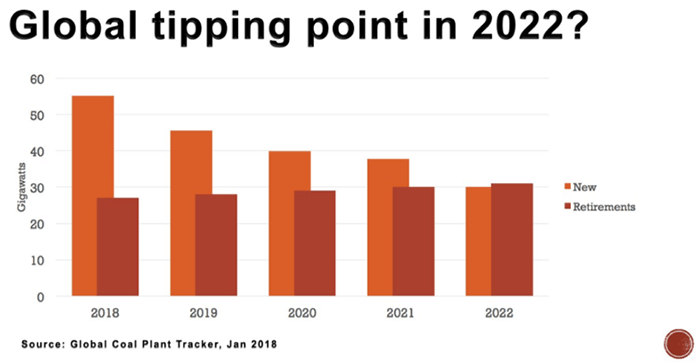
While good news, it’s really only the start of the hard work required to transition the world’s energy system to clean renewable energy. What matters far more than the date we hit peak coal plant, is the rate of retirement of the existing coal fleet. If we don’t rapidly shut down existing coal fleets around the world as early as 2030 in Europe and the US, we don’t stand a chance of meeting our Paris climate targets.
That’s the dire conclusion -of the University of Maryland School of Public Policy and Bloomberg Philanthropies recently released report “The State of Global Coal Power: Proposed New Capacity and Power Sector Decarbonization.” The report modeled current global coal construction against global climate goals and has stark findings. Actual coal plant construction may be slowing, but if we factor in overeager developers planning a massive pipeline of new coal plants, it will doom our ability to meet our climate targets. Worse yet, even if these plants never materialize, we still need to close down the world’s existing coal plants with a moon-shot intensity to ensure no more than 2° of warming.
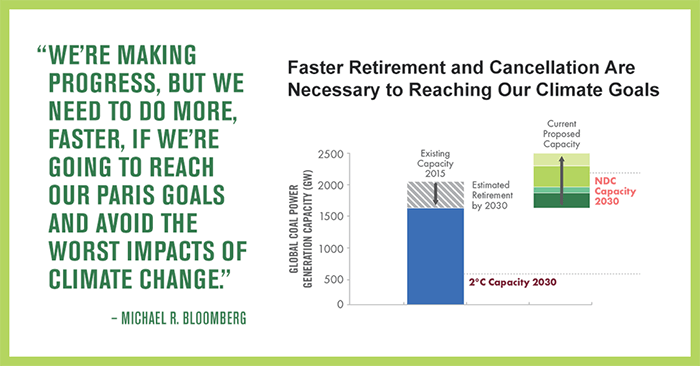
Which is exactly why the partnership announced at this year’s Bloomberg New Energy Finance (BNEF) summit between Michael Bloomberg and the Power Past Coal Alliance (PPCA) is extremely important. For years NGOs, such as the Sierra Club and Greenpeace, have been running sophisticated campaigns to slow down coal plant construction and help drive retirements, particularly in the United States and Europe.
However, the grassroots insurgency has been somewhat divorced from high-level political conversations about the future of energy. Instead in many countries, political leaders are desperately trying to revive the coal industry while some climate leaders are struggling to overcome the tremendous power of entrenched incumbents. Simply put, we have had a strong outside game, but historically lack a similarly strong inside game.
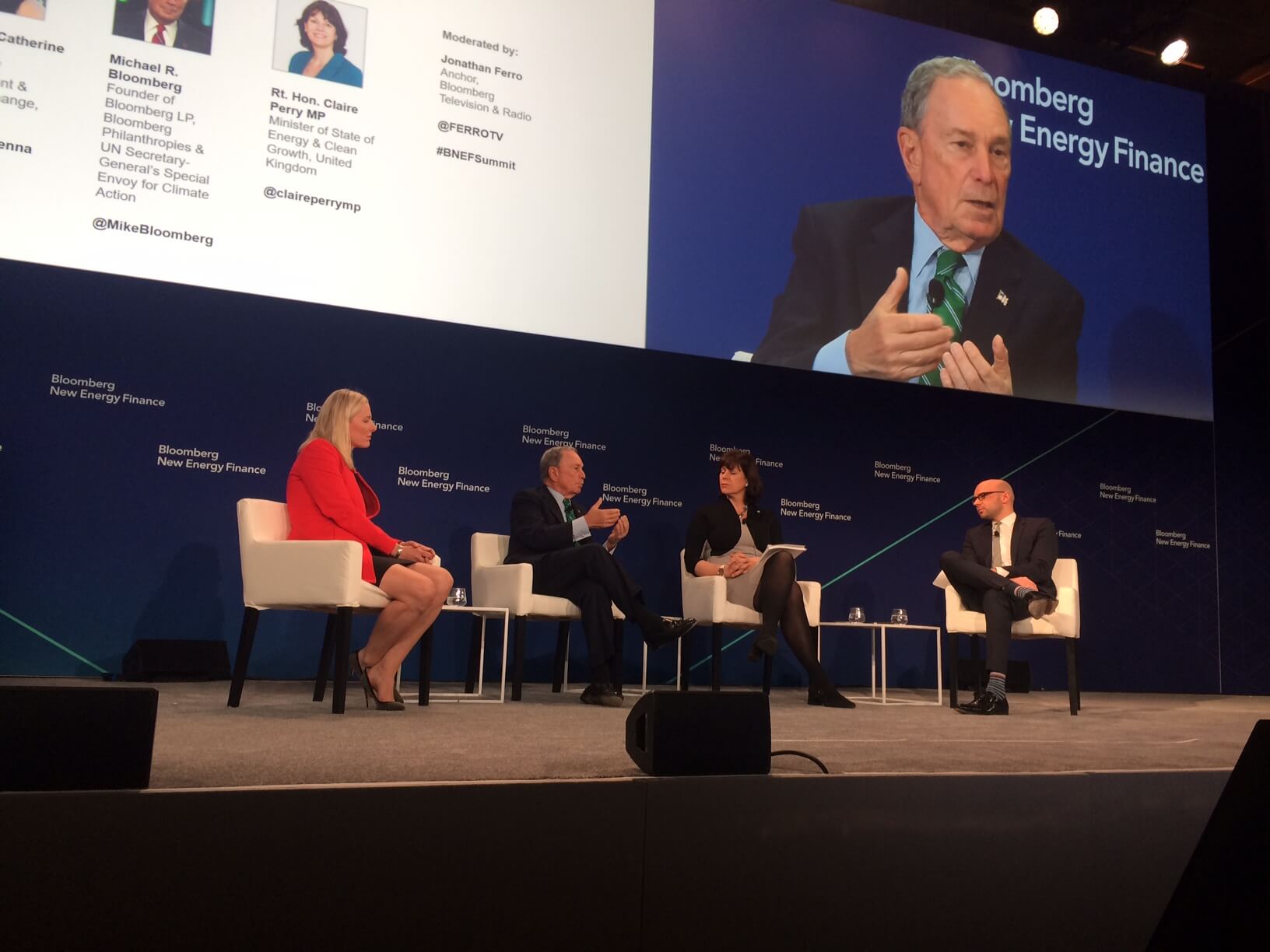
That’s changing. Thanks to leadership from Michael Bloomberg and the Canadian and UK governments, we now have a powerful influencer level conversation between the government and business sectors on how to accelerate moving beyond coal and transitioning quickly to economically and environmentally sustainable clean power. This quick transition also brings positive health and economic impacts. In 2016, the World Bank reported that because of outdoor and indoor air pollution exposure in 2013, the global economy suffered $5.11 trillion in losses attributable to illness or premature mortalities. With coal plant emissions’ significant contribution to global air pollution, closing existing coal plants would save money and lives.
This alliance will continue to grow and gain momentum as it opens the door for others to join in taking action. The question now is whether this high-level partnership can accelerate the advent of peak coal plant, and more importantly, move us beyond coal plants all together.

In which geographies are land use sectors a net sink of carbon dioxide, and in which are they a net source? How do land use emissions compare to those in energy-related sectors? How have these emissions changed, and how might they evolve? Analysts and policy makers can begin answering these questions with our expanded ClimateWorks Tracker, which allows users to make geographic and sectoral comparisons across several dozen climate indicators using data from ClimateWorks’ Carbon Transparency Initiative (CTI). New to the economy-wide modeling tool are data on land use emissions, along with modeling of Brazil’s greenhouse gas (GHG) emissions, a capability developed through our partnership with the System for Greenhouse Gas Emissions and Removals Estimates (SEEG), a platform developed by a consortium of Brazilian NGOs under the umbrella of the Brazilian Climate Observatory. These additions, available on a newly released Portuguese language version of Tracker as well as on our English and simplified Chinese versions, are shedding light on critical components of Earth’s climate system: forests and the ways that land use is affecting their climate-regulating services.
Forests are an indispensable component of the climate system, mediating inter-annual fluxes in carbon dioxide concentrations and sequestering mammoth quantities of carbon in their trees, grasses and soils. As deforestation and degradation of natural landscapes impair these functions, the need to understand forests’ contribution as net carbon sinks and how that contribution is changing becomes more urgent. The new additions to the ClimateWorks Tracker address the lack of transparency and complexity in the presentation of scientific assessments of the effects of forests, land use, and land use change on the net balance of GHG emissions. By enabling comparisons of land use emissions with projections, pledges, and scenarios, the Tracker promotes civil society’s ability to hold governments accountable with regard to these effects on the design, implementation and monitoring of public policies.
One geography where those emissions play an outsized role is Brazil, home of the world’s largest rainforest. Brazil was the first large forested country on the planet to systematically monitor rainforest cover loss. Since the 1980s, the country’s use of satellite image analysis has guided the design and monitoring of public policies to reduce deforestation in the Amazon. Many lessons learned are now being implemented in other biomes in Brazil and shared with other forested countries in Latin America, Asia and Africa through South-South cooperation initiatives.
Through partnerships with multiple Brazilian NGOs under the SEEG consortium, we teamed up with national and international experts and created an all-new CTI model of Brazil’s greenhouse gas emissions. Relying on local official data sources, this model elucidates the activity and intensity metrics that drive GHG emissions in Brazil on a yearly basis. We will use this information to track decarbonization progress, as with our models of other geographies, and we have integrated the results into the previously published Regions, Sectors, and Metrics dashboards on the ClimateWorks Tracker website to allow comparisons of key climate indicators for Brazil with other CTI geographies, including China, the EU, India, Mexico, and the US.

Brazil’s Paris Agreement commitment to reduce GHG emissions highlights the opportunity the country has to make a significant contribution to the global goal of limiting temperature increases to well below 2°C. Endowed with abundant low-carbon energy resources and vast expanses of forests, Brazil is nevertheless haunted by the possibility of a surge in fossil fuel use and the undoing of hard-fought victories on progress halting deforestation. However, by fulfilling its Nationally Determined Contribution (NDC) presented in Paris and the goals from its National Policy of Climate Change, Brazil could ensure that its land use change and forests GHG emissions would become net negative by 2030.
It is the duty of civil society organizations to support NDC pledges, in part by speaking forcefully against deforestation trends, and integral to that effort are open and transparent data and tracking services. The updated ClimateWorks Tracker now not only provides those services with regard to land use but also contextualizes land use emissions and sinks relative to those in the energy-related sectors.

As mid-century and other longer-term emissions reduction strategies emerge, the focus on these carbon fluxes will intensify as nations strive to reach net-zero carbon emissions. Development of the Brazil model offered an excellent opportunity to collaborate with local land use experts engaged on the fluxes (including Imaflora and Imazon). We have since rolled out similar methodologies for all other CTI geographies and have made results available in a newly designed Land Use Dashboard. With other local partners, including the Climate and Land Use Alliance (CLUA), we will next use the CTI models to explore how the agricultural sector could contribute to reducing emissions associated with livestock and crop production.


